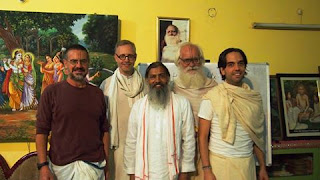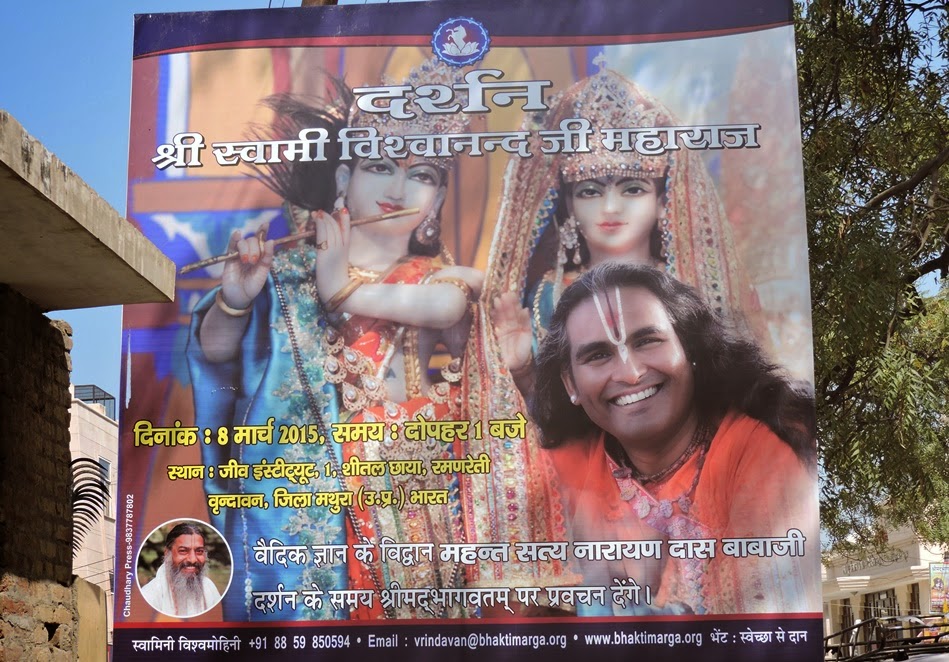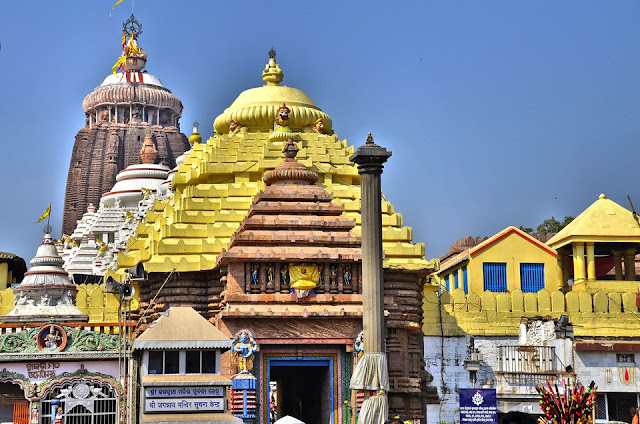Three weeks of Bhakti Tirtha completed
This is the team of teachers at the Karttik session of the Bhakti Tirtha course at Jiva Institute. From left to right, Dr. Edwin Bryant, Dr. Måns Broo, Dr. Satyanarayana Dasa Babaji Maharaj, my alter ego, and Dr. Matthew Dasti.
The first three weeks will conclude tomorrow after which Dr. Bryant and Dr. Dasti will be be going back to their real lives. The three weeks went by far too quickly. It is, of course, madness to think that they would be able to find the time away from their other obligations to do this entirely voluntary service in Vrindavan.
Babaji has gotten the students working on Sanskrit quite intensively. Our two guest lecturers have gone into the nitty gritty of Yoga Sutra and Nyaya, thereby generating a lot of philosophical questioning about God and the nature of God, etc., the reality of the world, and so on, as well as making these texts relevant to Gaudiya Vaishnavas in other ways.
The collegial spirit of the teachers and the students, which has people from a very wide spectrum of backgrounds, from those who are still quite new to Vaishnavism to a number of war-weary Prabhupada disciples who hunger to deepen their engagement with the Vaishnava literatures in as authentic a manner as possible.
Dr. Broo (Bhrigupada Das), a longtime friend of both Babaji Maharaj and myself, was passing through and gave one informative lecture about his research work on Radha Tantra (recently completed and on the way to publication) and Hari Bhakti Vilasa (currently underway).
We do have the good fortune of being in Vrindavan, and so it is natural for devotees to come traveling through. And of course there are other scholars who are researching Vrindavan or Vrindavan-related topics. So the prospects of creating a vibrant devotional-academic environment for serious students looking to do a profound study of the Gaudiya Vaishnava canon and the surrounding knowledge environment,, and at the same time to be creative in terms of "practical Vaishnavism," are quite extensive.
The discussion following Bhrigu's presentation led to some interesting comments by Babaji Maharaj.
He said that the Gaudiya sampradaya is not one sampradaya but many out of design, principally because despite the preeminence of sankirtan, Rupa Goswami and Hari Bhakti Vilasa allow for much individual freedom in how one supplemented that activity, allowing for various tastes to arise.
I asked the question about Bhaktisiddhanta Saraswati's distinction between Pancharatra and Bhagavata traditions and the question of mantra diksha being particularly relevant to the former (though present in both).
Babaji's answer was particularly cogent. He said that the Goswamis in Vrindavan established no specific diksha parampara. None of them took multiple disciples, but chose instead to write books. There being many angas of bhakti, Rupa Goswami himself says, and is quoted by Kaviraj Goswami, as saying that one can practice them all or just one. By the practice of any one of them, one can attain perfection.
So, he said, the Gaudiya Vaishnava sampradaya does not really have a single stream, but many with differing approaches to the practice. This freedom has been freely given by Sri Jiva also. There is no single overarching ecclesiastical authority that governs Gaudiya Vaishnavism. Unlike our old alma mater, of course.
This could be a very liberating idea.
Bhrigu's PhD thesis was on the subject of guru tattva and you can read it freely on line: "As Good as God" by Måns Broo.
Some related articles from this blog:




Comments